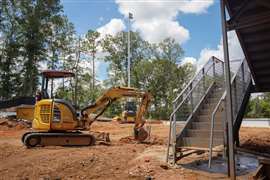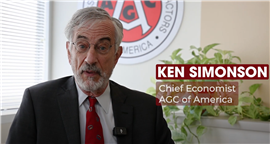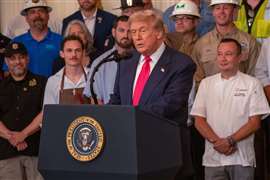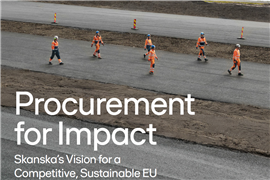Read this article in French German Italian Portuguese Spanish
US immigration raids: Why contractors can’t wait for government to solve skilled worker squeeze
01 September 2025
The US construction industry is navigating 2025 with a workforce gap that shows no sign of closing. Immigration enforcement is tightening, tariffs are raising uncertainty, and nearly nine in ten firms still can’t fill openings for craft workers.
 A construction site near Mobile, Alabama, US, facing shortages of migrant workers due to the pace of immigration-related raids in the region. Image: Reuters/Megan Smith
A construction site near Mobile, Alabama, US, facing shortages of migrant workers due to the pace of immigration-related raids in the region. Image: Reuters/Megan Smith
That was the blunt picture painted in the latest workforce survey released by the Associated General Contractors of America (AGC) and the National Center for Construction Education and Research (NCCER).
The findings were shared during a 28 August webinar and, even though there’s plenty to be concerned about, there were some solutions that could help increase the labour pool, work around higher material prices and get back to building profit.
The survey results were presented by AGC chief economist Ken Simonson, with prerecorded remarks from AGC CEO Jeff Shoaf and commentary from NCCER President Boyd Worsham. The panel also featured Alabama contractors Hasting Sykes (S.S. Weaver General Contractors) and Mike Scarborough (Rabren General Contractors), and Steve Levy (McCownGordon Construction) of Kansas City, with AGC’s Brian Turmail moderating.
Together, they sketched out a picture of a workforce challenge that is deepening under intense immigration enforcement, decades-long skilled labour shortages, and uncertain federal policy.
The panel sought to find answers to: How exposed is construction to immigration crackdowns? What are contractors on the ground experiencing? What solutions are they turning to when federal relief seems unlikely? And, is there any reason to expect state or national policymakers to ease the pressure?
These are important questions for construction because at stake is whether US contractors can find enough qualified workers to meet demand, or whether projects will continue to be delayed and costs pushed higher.
Digging into immigration data and what it means
 AGC Chief Economist Ken Simonson in the association’s “2025 Mid-Year Economic Update” video. (Image courtesy Associated General Contractors of America)
AGC Chief Economist Ken Simonson in the association’s “2025 Mid-Year Economic Update” video. (Image courtesy Associated General Contractors of America)
To open, Simonson presented stark figures from an AGC/NCCR member survey and US Census Bureau data analysis.
He noted that about one-third of US construction trade workers are foreign born, compared with less than one-in-five workers in non-construction sectors. In Texas, California, New Jersey, Maryland and Washington, D.C., half or more of construction trade workers are foreign born. In building trades like insulation, drywall, and roofing, as many as 61% are foreign born.
Simonson said, “5% [of surveyed contractors] report a job site, or other sites such as their office, was visited by immigration and agents. Ten percent said workers left or failed to appear because of actual or rumoured immigration actions and 20% report subcontractors lost workers, [and] it’s likely even more firms will be affected in the coming months.”
The survey was conducted immediately after Congress passed a reconciliation bill in July, which contained what Simonson described as “huge increases in funding and resources for immigration enforcement.”
Responding to the data, Worsham added, “My sense is [some workers] are laying low because, even if they are legal, I think there’s a fear of a raid and them being called up into something that is very disruptive to their family and to them.”
Is there hope the US and state governments will provide relief?
 US Immigration and Customs Enforcement (ICE) officers question construction workers in Texas’ Rio Grande Valley region. The agency said it arrested 25 undocumented workers at two construction sites as part of enforcement operatoins. (Image: ICE)
US Immigration and Customs Enforcement (ICE) officers question construction workers in Texas’ Rio Grande Valley region. The agency said it arrested 25 undocumented workers at two construction sites as part of enforcement operatoins. (Image: ICE)
In response to a Construction Briefing inquiry on whether federal or state governments are listening to industry concerns and developing meaningful labour upskilling initiatives, Simonson pointed to years of gridlock in Washington D.C., while AGC’s Brian Turmail added the association is escalating its outreach to policymakers.
Worsham noted that local programmes are stepping up where federal action has stalled.
Turmail said, “We’re actually going to be launching digital advertising targeting the White House, Congress, the Department of Labor, the Department of Homeland Security, with data from this survey beginning next week.
“We do have a perception that some federal officials don’t appreciate the extent of labour shortages in the construction industry.”
Simonson added, “We’ve been trying to get [a construction-specific visa] for [about] 20 years. I’ve been with AGC for almost 24 years, and I know this has been high on our wish list for a long time, [and that] just shows the gridlock that there is.”
What US contractors are saying
With the data showing how exposed construction is to immigration policy, the conversation turned to what contractors are seeing in their regions and how stepped-up enforcement is compounding what has already been a chronic, decades-long shortage across the industry.
Sykes of S.S. Weaver said, “This is not a new issue for us. It’s an old issue. We’ve been talking about it generationally among our peers, as we’ve observed the industry over 30 years.”
A global recession in 2008 drove many skilled workers out of the industry, and the disruption of COVID “really didn’t help either,” noted Rabren’s Scarborough.
Now, historically high import tariffs are an added burden. While the webinar focused largely on labour, US import tariffs were a frequent talking point.
Scarborough pointed to one example from his own firm: “We pre-purchased some [raw steel] coil that we have on a 350,000-sq-ft building… in order to avoid an increase in pricing.”
But he also raised the lingering uncertainty: “How do you manage the risk of who covers the cost for tariffs once implemented? Once you go to contract on a project and, all of a sudden a tariff is enacted, who pays the overage for that?”
The contractors made clear that, even though the combination of factors make present circumstances difficult to pilot, standing still is not a viable option.
What solutions they are using?
 A worker trains on a virtual reality headset. Image: Adobe Stock
A worker trains on a virtual reality headset. Image: Adobe Stock
AGC’s survey found firms are relying on a mix of familiar tactics to shore up their workforce and manage risk.
Seven out of eight firms reported raising base pay in the past year, even as pay increases slowed in most other industries. Some 42% increased spending on training and professional development. More than half turned to digital recruitment, with 55% using social media and targeted advertising, while 52% built connections with career programs at high schools and colleges.
“We’ve reached out to junior colleges,” Levy said, noting that high school initiatives can be productive, but some contractors may run into regional restrictions on recruiting under-18 workers for future hire.
He explained, “We’ve developed a two-year program with the junior colleges to send us a graduated technician…similar to the qualifications of a four-year college. That’s helped, because the biggest need we have here in Kansas City is attracting professional workforce, the superintendents, [and] the project managers.”
Worsham underlined how fragile the pipeline remains.
He noted, “Out of about 325,000 students that go into design- or construction-related educational paths…only about 22% of those students come into the industry on average.
“We are still missing…one-hundred-and-some odd thousand students each year.”
What should construction do?
With Washington at a standstill and enforcement pressure set to rise, panellists agreed that contractors will need to take the lead.
Simonson cautioned that the July reconciliation law means stepped-up activity is only beginning.
“[It]…greatly increases funding…for immigration enforcement. So, I think it’s early-days, yet.”
Even so, firms remain mostly optimistic.
“62% of the construction firms…do expect to add employees in the next 12 months,” Simonson said.
That confidence sits alongside a clear charge from the discussion: keep widening the pipeline through training partnerships and direct outreach while tightening project risk management around materials and labour.
And for owners hesitating in the face of tariffs, contractors urged decisiveness.
As Steve Levy put it, “Build now. Prices don’t go backwards.”
Self-reliance is key for construction
The AGC/NCCER survey paints a consistent picture: US contractors face ongoing workforce shortages made worse by immigration enforcement and tariff uncertainty.
Looking up for help from the federal government to reduce the shortage is likely to only result in a proverbial stiff neck.
State and local initiatives, like training centres or union programmes, have showed promise. But the industry’s biggest issues will need to be solved at the site and office level: contractors are raising pay to entice and retain skilled workers, investing in education, and working directly with schools. As for high material costs and mounting tariffs, the best advice is to pre-purchase materials (in bulk, when possible) while building good relationships with suppliers to help negotiate the best rates.
The consequences of standing still will be negative, not just for individual firms and the industry, but for the entire US economy.
Simonson concluded, “Our goal is to make sure the construction industry remains a driver of economic growth in this country. The best way to do that is to ensure that it has the workforce and the demand needed to continue building the American economy.”
STAY CONNECTED



Receive the information you need when you need it through our world-leading magazines, newsletters and daily briefings.
CONNECT WITH THE TEAM
















